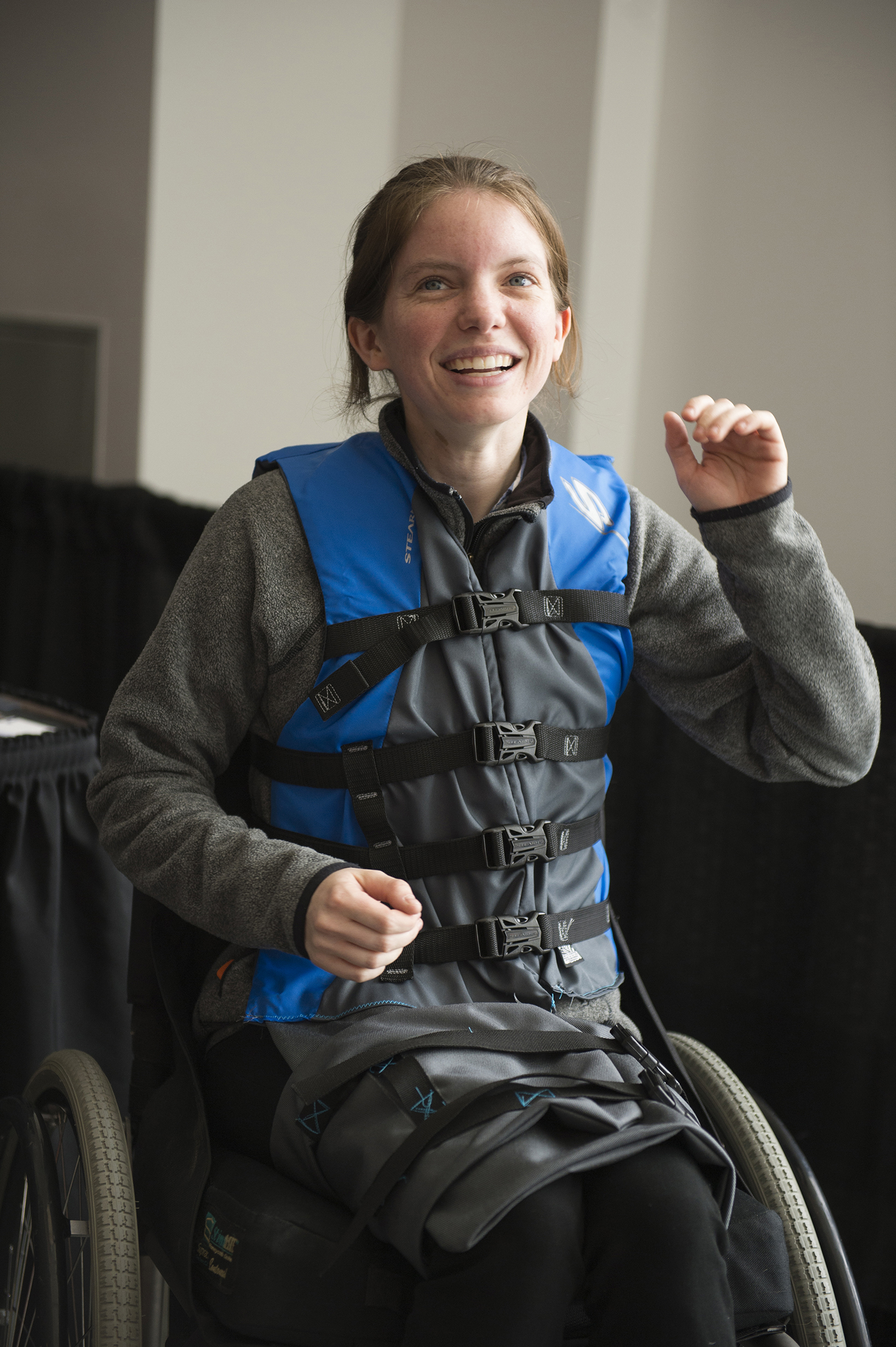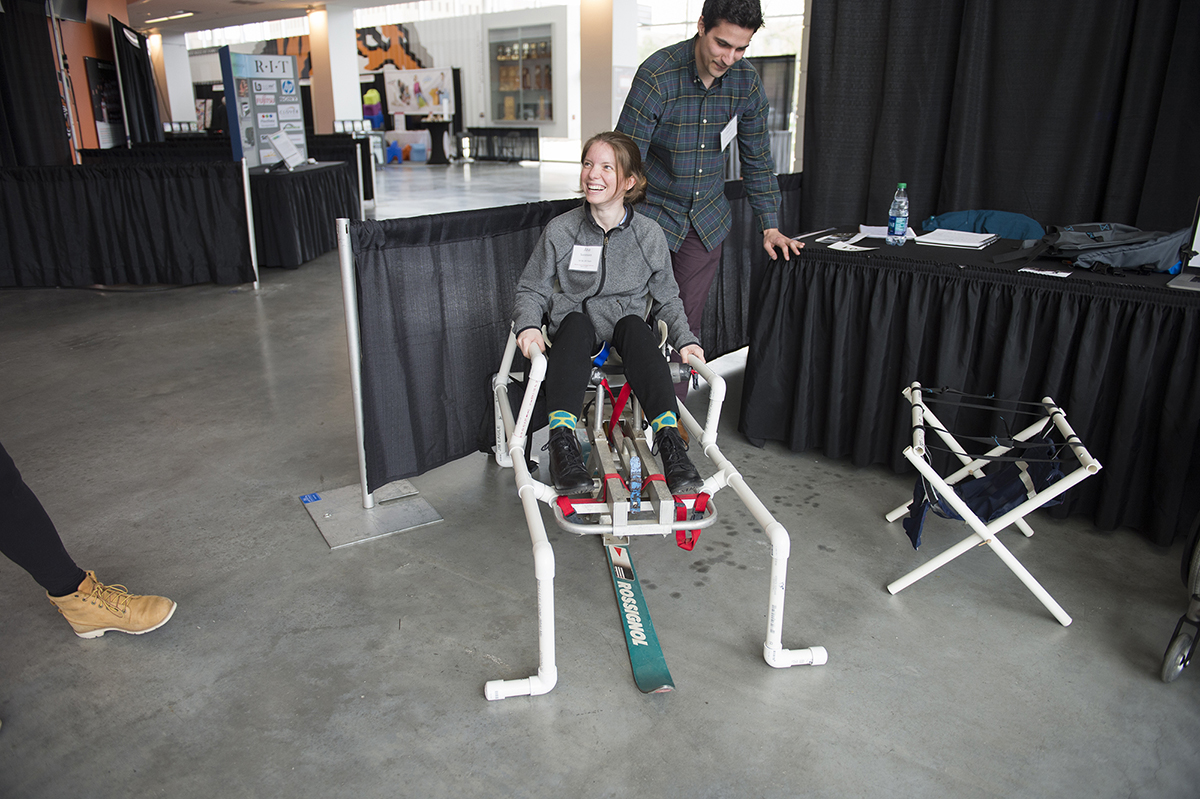ID majors spearhead push for improved transfer lift for adaptive ski programs
What started as an IdeaLab@RIT focus has turned into a product that has undergone development.
And a pair of RIT College of Art and Design students are on the frontline of that.
IdeaLab is a bi-annual event where RIT students and faculty gather for a weekend and collaborate on uncovering possible solutions, in a rapid manner, to a client organization’s real challenges. It’s sponsored by the Simone Center.
When David Villarreal (first-year MFA industrial design major) and Ana Sorensen (second-year BFA industrial design) partook in IdeaLab, one of their tasks was to create a transfer lift for adaptive ski programs.
With IdeaLab’s tight time constraint, participants could only have a cup of coffee with each concept. But the project resonated with Villarreal and Sorensen, who identified troubling problems with the current methods currently available for skiers with impaired leg movement looking to go from a wheelchair to a sit ski, and vice versa. They stuck with it and got the green light to continue development, with the Simone Center providing funding.
Villarreal and Sorensen presented their transfer lift idea at the Effective Access Technology Conference April 21 at the Gene Polisseni Center. Their system — which has yet to go through a user-testing phase, as of the conference — places emphasis on the dignity and independence of sit ski users and making it a more efficient transfer from wheelchair to sit ski, and back.
“It’s just a safer way to get in and out so they don’t put a lot of strain (on themselves),” Villarreal said. “How they get in and out of the sit ski and how they get out of their wheelchair is kind of unnatural. It can put strain on their joints in bad ways.”
It’s a collaborative, multidisciplinary effort, as the ID majors have teamed with fellow RIT students Tom Janosky (mechanical engineering technology), Chris Shyne (mechanical engineering technology) and Samkit Lunawat (MS entrepreneurship and innovative ventures). They’ll all exhibit their lift device at Imagine RIT Saturday in Student Innovation Hall (room 1600) inside the Simone Center.
They are working with Shared Ski Adventures, an adaptive learn-to-ski program at Swain Resort that helps people with disabilities become independent skiers. Swain is a little more than an hour south of Rochester.
The RIT group is attempting to perfect a scissor lift design, with mechanical, battery-less power. Users would wear a harness that hooks onto the lift at key points and a crank system will move them from one seat to the other. The harness can easily be put on and removed while the skier is seated.

“It’s a pretty quick system,” Sorensen said. “In terms of independence and not having to do this whole process before they can even get to the mountain is definitely a little bit more convenient.”
“They’ll need someone else to pull the sit ski out and bring the wheelchair in or vice versa,” Villarreal said. “… This device, ideally, wouldn’t be that high off the ground, would be pretty lightweight and portable; the legs can fold. Lightweight on the snow is a huge issue as well. All that kind of stuff is taken into account.”
The factors that the RIT team is considering with every move are deficiencies of the present transfer procedures.
A manual transfer requires multiple lifters — volunteers perform this task at Shared Ski — but it’s physically taxing and an awkward motion on slippery ground, causing injuries, Villarreal said.
Self-transfer calls for great upper-body strength and stability during that transition is tough to gain. Modified Hoyer lifts, which are common in physical-therapy settings, are not portable nor do their electrical components translate well to snowy settings, heavy and the single-arm “crane” style can be emotionally disconcerting to the participant.
So the goal is to alleviate the accidents, lower the lift to the right height from the ground and not make “the participant a spectacle,” Villarreal said.
“At the forefront is just dignity,” Villarreal said. “And the lifters can be as involved as the participant wants them to be involved. So they can be independently doing this for themselves, or they can have someone else do it for them if they can’t.”
Sorensen said it’s been an iterative process filled with tweaking many concepts and ideas. But, at the conference last month, she said she believes some of the prototypes are ready for testing to “see if you can actually transfer yourself from a chair, or if this sling holds up and it can fit a range of people.”





